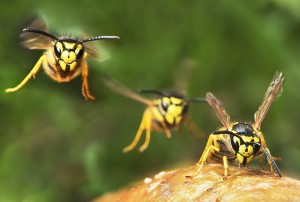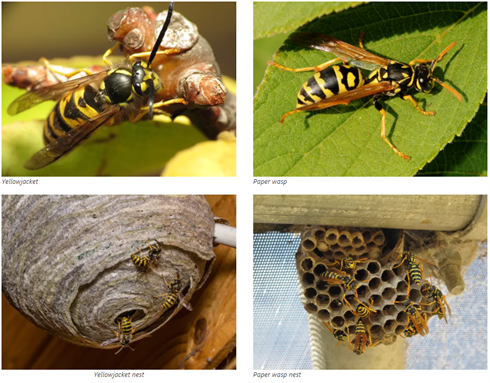
Learn how to control yellowjackets with these tips from the City of Goleta Environmental Services Division.
Yellowjackets can be annoying and intimidating pests at picnics and around the barbecue, especially in late summer. On the positive side, they prey on many other insect pests such as caterpillars and flies.
Before you take steps to get rid of yellowjackets around your house or yard, be sure the problem is yellowjackets! Less aggressive flying insects, such as paper wasps, mud daubers, and honeybees, are often mistaken for yellowjackets.
Yellowjacket or Paper Wasp?
Most often, paper wasps are mistaken for yellowjackets. Yellowjackets are shorter and rounder than paper wasps. A paper wasp’s body is longer and thinner, with long, dangling legs. Yellowjacket nests are round and are enclosed in a papery shell with a small entrance hole at the bottom. They build their nests in abandoned rodent burrows and other holes in the ground, in attics, in wall voids, and in shrubs and trees. Sometimes they hang their nests from eaves. Paper wasp nests usually hang from eaves or porch ceilings and look like tiny umbrellas filled with six-sided cells.

Getting Rid of Yellowjackets
If you often find several yellowjackets in your home, you may have a nest inside your walls. To protect yourself and your family from getting stung, call your local vector control district or a pest control company for help getting rid of the nest. Look for a pest control company that specializes in less-toxic pest control methods. The pest control professional should only need to use poison bait if you have very large numbers of yellowjackets.
Keep yellowjackets from building a nest in your house:
- Seal holes and cracks in foundations, walls, roofs, and eaves.
- Cover attic and crawl space vents with fine mesh insect screen.
- Yellowjackets scavenge for meat and sweet foods and drinks in outdoor garbage and recycling bins. Clean recyclables before throwing them in the bin and keep garbage cans clean and tightly covered.
Trapping Yellowjackets
Trapping can help control yellowjackets if there aren’t too many. You can find both disposable and reusable traps in home and garden centers.
- Follow label directions for setting traps, disposing of trapped yellowjackets, and cleaning reusable traps.
- A few hours before you bring food outdoors, set traps around the edge of your yard. Make sure traps are well away from picnic areas, to lure yellowjackets away from people and food.
- If one of the traps is not attracting yellowjackets, move it. If you see yellowjackets but none of the traps is attracting them, try changing the bait.
- In the spring and early summer, yellowjackets are looking for protein. Use strong-smelling baits such as tuna-flavored cat food.
- In late summer and fall, yellowjackets need sugar. Use grenadine, or the sweet-smelling bait that comes with the traps.
- Putting out traps in early spring may capture queens and reduce the number of nests in the area.
Avoiding Yellowjacket Stings
If you have a yellowjacket in your house, do NOT make the yellowjacket mad by swatting at it! Wait until it lands on a flat surface, and then place a glass or plastic container over the insect. Slide a stiff piece of paper under the opening of the container and take the covered container outside and release the insect.
When a yellowjacket comes near:
- Stay calm—or at least move slowly. Slow, gentle motions that mimic the movement of a branch in the breeze will be more likely to get the yellowjacket to leave.
- You can brush a yellowjacket off with a piece of paper or some other object as long as you move slowly and deliberately.
- Do not squash a yellowjacket. When crushed, many kinds of yellowjackets give off a chemical that can cause other nearby yellowjackets to attack.
Yellowjackets can be a problem in May and June, but they are most irritable and aggressive late in the summer. Follow these tips to help prevent stings:
- Wear protective clothing when mowing grass if you think there might be underground nests nearby.
- Outdoors, keep soft drinks or other sugary drinks in closed containers. Use cups with lids and straws, and always look before you sip. Do not carry snacks containing meat or sugar in open containers.
- Do not wear perfumes. Use unscented products on your hair and body.
- Avoid going barefoot, especially when walking on grass or another groundcover.
- Always check for yellowjackets on wet towels or wet clothing left outside before you pick them up.
- Wear light-colored clothing without patterns.
- If you are allergic to yellowjacket stings, avoid outdoor cooking and eating, and wear clothing that covers as much skin as possible. Carry an epinephrine kit (available by prescription) at all times.
Find more information on controlling yellowjackets with eco-friendly products in our OWOW brochures in English and Spanish.
The City of Goleta along with the Cities of Buellton, Carpinteria, Solvang, Santa Barbara, Santa Maria and the County of Santa Barbara have partnered with the OWOW organization to promote the use of less-toxic products in an effort to reduce pesticide pollution in our communities. By reducing pesticide use and the use of less-toxic products around the home, you can help reduce pesticides and other pollutants such as herbicides and fertilizers from being picked up while watering or when it rains and transported to the nearest storm drain inlet and into our waterways. The OWOW website is user-friendly and a great resource for finding less-toxic products to use around your home or garden.


